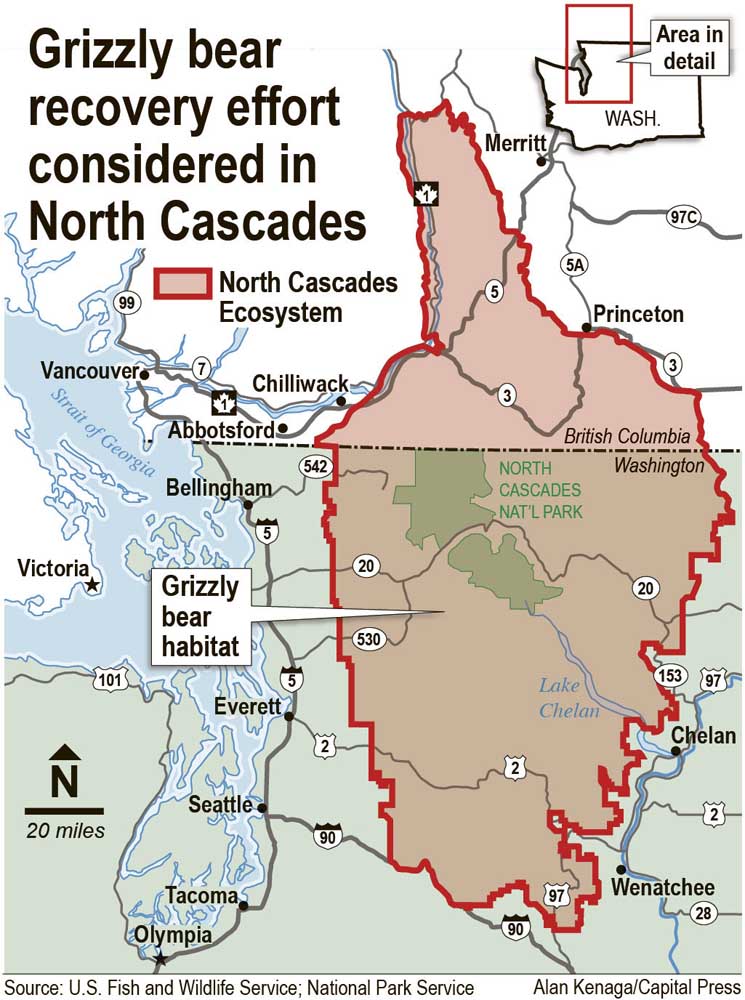Park Service receives 120,000 comments on grizzlies
Published 8:00 pm Thursday, May 11, 2017

- Park Service receives 120,000 comments on grizzlies
SEDRO WOOLLEY, Wash. — The National Park Service has received more than 120,000 public comments on its plans to reintroduce grizzly bears in the North Cascades.
A public comment period began in early January and was to end March 14 but was extended to April 28 at the request of the public and local officials.
More than 120,000 comments were received, and it will take three to six months for NPS to process them, said Denise Shultz, spokeswoman at the North Cascades National Park Service Complex in Sedro Woolley.
An analysis of the comments won’t include how many were from out of state or how many are for reintroduction, but will be more along the lines of identifying things or alternatives that NPS and the U.S. Fish and Wildlife Service may have missed that may need further data or study, Shultz said.
The comments focus on a draft environmental impact statement that includes a no-action alternative and three alternatives to restore a reproducing population of about 200 bears by bringing them in from other areas.
Restoring grizzlies would “enhance the probability of longterm survival and conservation of grizzly bears in the contiguous United States, thereby contributing to overall grizzly bear recovery and greater biodiversity of the ecosystem,” the agencies have said.
Grizzlies were listed as a threatened species in the contiguous U.S. in 1975. They were listed as endangered in Washington state in 1980.
A final environmental impact statement may come late this year or early next year, with a decision a month or so later, Shultz said.
U.S. Rep. Dan Newhouse, whose district includes part of the North Cascades, sent a letter to Karen Taylor-Goodrich, superintendent of the North Cascades National Park Service Complex, March 17 expressing his “firm opposition” to the plan.
The general consensus of people attending a March 2015 forum in Okanogan on the issue was “that their concerns were not being taken seriously by federal officials,” Newhouse wrote.
He noted that the last confirmed sighting of a grizzly in the North Cascades was in 1996 and that the agencies’ draft environmental impact statement found it “highly unlikely that the area contains a viable grizzly bear population.”
That raises questions about the need for restoration, he wrote.
On April 27, a Newhouse aide said the congressman is “continuing conversations” on the issue with new Interior Secretary Ryan Zinke, a former Montana congressman.
Okanogan County ranchers already coping with coyotes, cougars and wolves say they don’t need another apex predator killing and harassing their cattle.
“At the public meeting, it was clear there’s a predetermined outcome and that NPS doesn’t care to hear from local people who will be impacted. The whole format of the meeting was to stifle public input and indoctrinate attendees on the benefits of grizzly bear,” said Nicole Kuchenbuch, an Okanogan rancher and president of the Okanogan Farm Bureau.
“Congress needs to cut the funding. I don’t know the chances, but we do hold out hope, the way the Trump administration is rolling out executive orders, that it might save the day,” Kuchenbuch said.
Chelan and Skagit counties have hired an attorney skilled at invoking local jurisdiction and Okanogan County is considering joining them, said Jim DeTro, an Okanogan County commissioner.
The Washington Outfitters & Guides Association in Twisp has hired an attorney active in opposing the Endangered Species Act, DeTro said.
Organizations, counties, the Washington Farm Bureau and the Eastern Washington Council of Governments (of 13 counties) are against reintroduction of grizzlies, he said.




